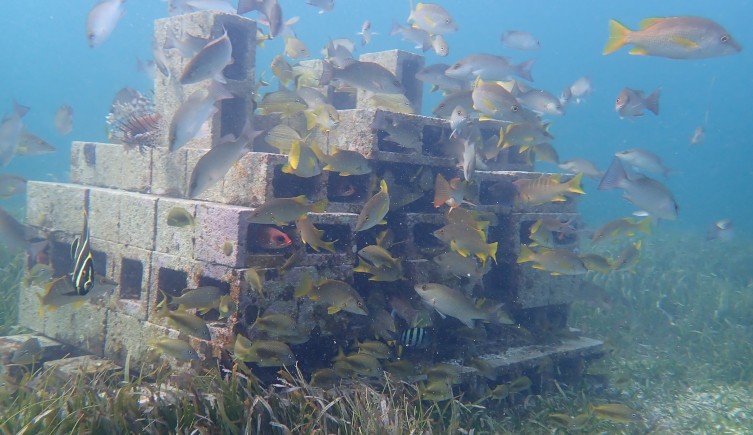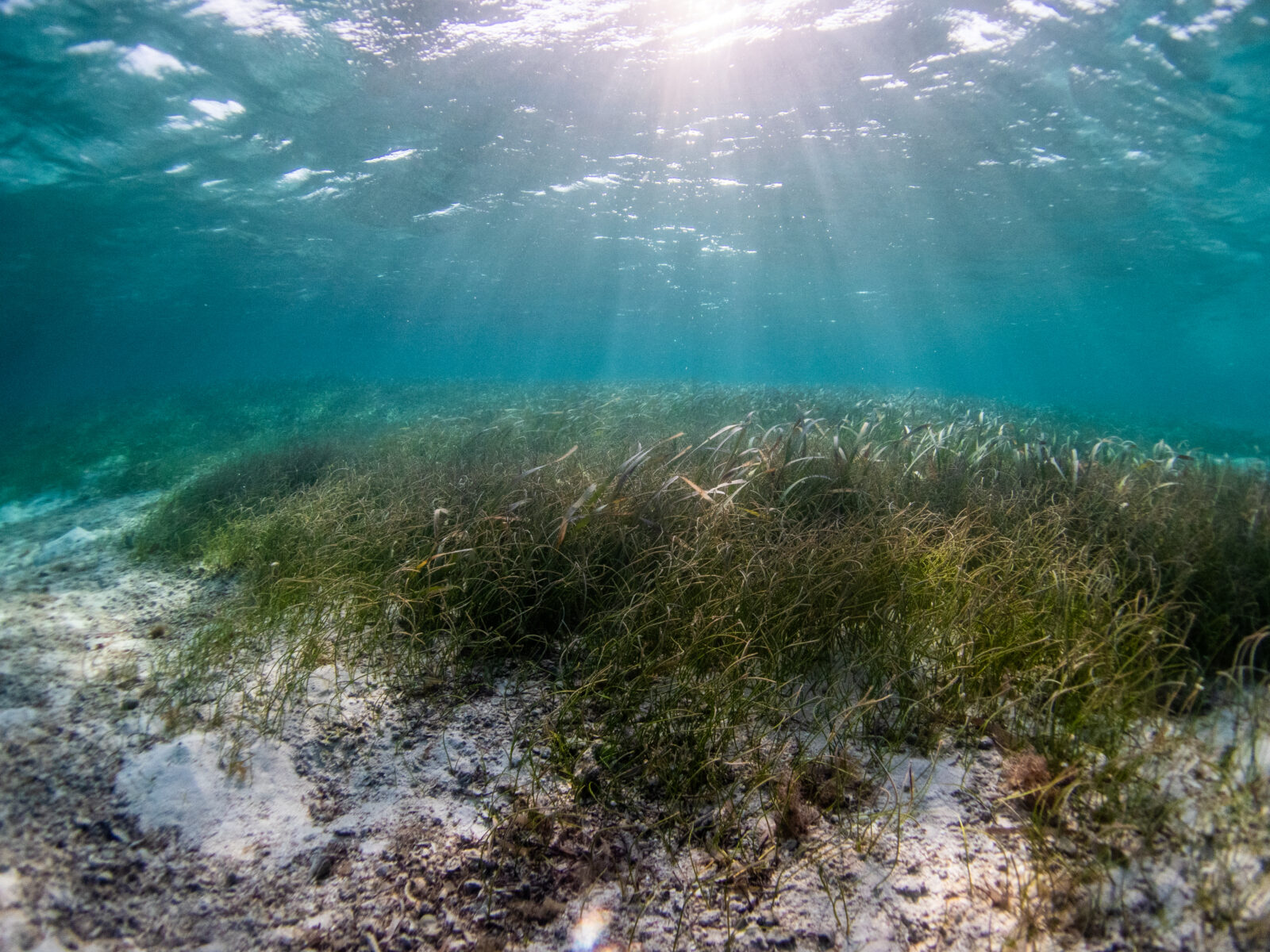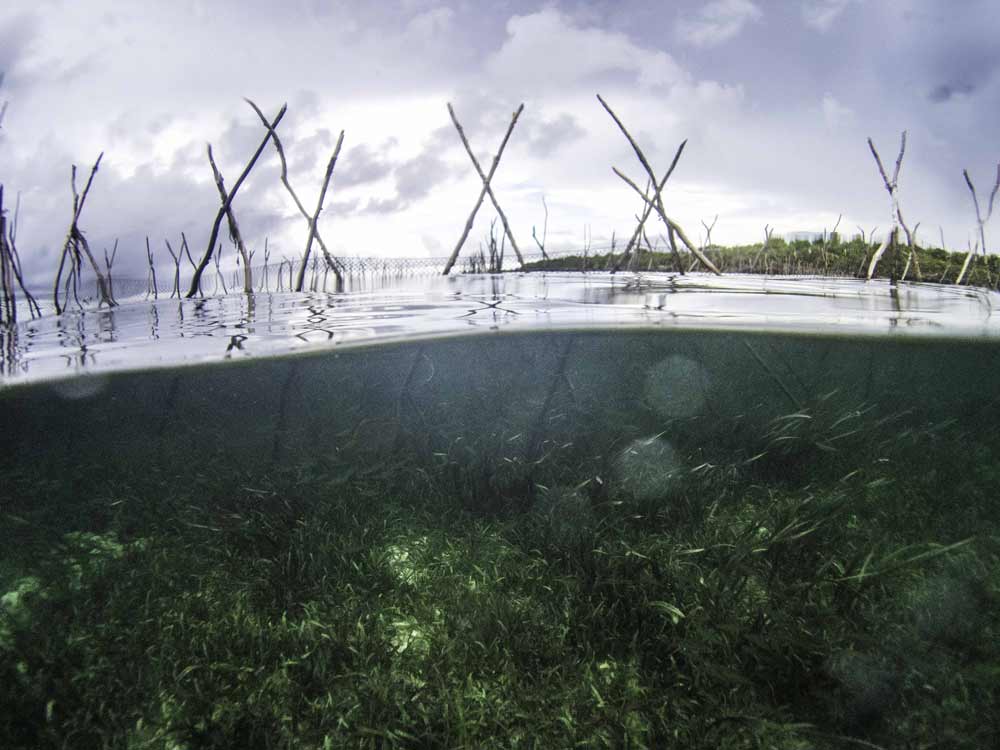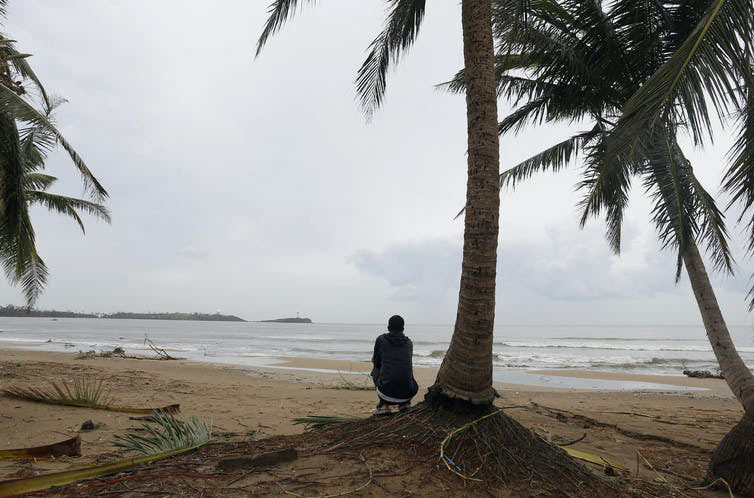Seagrass production around artificial reefs is resistant to human stressors

Artificial reefs might help to restore the ocean’s ability to fight against climate change. The reefs boost the productivity of seagrass meadows by attracting fish, which can improve the ability of these habitats to lock up more carbon dioxide beneath the waves. Breeze blocks placed in one of the ocean’s most endangered habitats provide an unexpected lift for fish. Seagrass meadows are found across the world, reaching from the tropics up into the lower reaches of the Arctic circle. They are incredibly valuable habitats, providing a nursery for young fish as well as sucking vast quantities of carbon dioxide from the atmosphere. However, with an area of seagrass the size of a football pitch being lost every 30 minutes, it’s more important than ever to find out how to turn things around. A new study in the Caribbean has shown that artificial reefs can help to bolster their growth in the tropics, even as threats such as fishing and nutrient pollution continue. Dr Jacob Allgeier, a co-author of the paper, says, ‘By attracting fish, whose faeces provide concentrated nutrients for the seagrass, the artificial reefs increase the primary production of the entire ecosystem.’ ‘We are now investigating how this cascades up the food web. The new energy has to go somewhere, so we are quantifying how it affects invertebrates and fish with our evidence suggesting that it is fuelling increases in both.’ The findings of the study were published in Proceedings of the Royal Society B. Artificial reefs and seagrass One of the biggest issues affecting seagrass is nutrient pollution, often from the release of human sewage. While the influx of nutrients can initially boost the growth of the meadows, it also promotes the growth of algae which reduces the amount of sunlight getting to the seagrass and harms it in the long run. Alongside fishing which causes levels of the fish faeces that fertilise the meadows to drop, it was thought that the combination of these two issues might work in unexpected ways to hinder the growth of seagrass. But the current study has revealed some surprising results. It has found that the productivity of seagrass in both disturbed and undisturbed meadows was increased by the presence of an artificial reef, while algae didn’t actually seem to pose an issue, even in areas where nutrient pollution was high. Mona Andskog, the PhD student who led the research, explains, ‘Artificial reefs built in seagrass create a positive feedback loop. They attract fish that use the reefs for shelter which, in turn, supply new nutrients from their faeces that fertilise the seagrass around the reef.’ ‘This increased primary production can increase invertebrate production by providing more food and shelter for invertebrates, which in turn provide more food for fishes.’ Experiments in Haiti, at some of the most fished sites included in the study, also showed that the artificial reefs were providing additional benefits to the fish. Large numbers of small fish were found at the site because of the difficulty in using nets around the reef, meaning that the overall biomass of fish was at times larger than in unfished areas measured elsewhere in the study. While artificial reefs present a promising option for tropical seagrasses, they’re likely to have a much more limited impact on temperate meadows. These waters already tend to have higher nutrient levels, meaning that any contribution the reef would made to overall growth would be small. The scientists now hope to explore how the placing of artificial reefs can affect seagrass ecosystems, as well as expanding their research to the Dominican Republic. ‘We will be testing how different configurations of artificial reef clusters can affect the production and fish community composition,’ Jacob says. ‘This includes the number of artificial reefs in each cluster, as well as their arrangement.’ ‘As with this research, we hope to simultaneously use the reefs to test fundamental questions about production in these highly impacted ecosystems as well as optimising the positive feedback that is initiated by the artificial reefs.’ More information: Mona A. Andskog et al, Seagrass production around artificial reefs is resistant to human stressors, Proceedings of the Royal Society B: Biological Sciences (2023). DOI: 10.1098/rspb.2023.0803 This story is republished courtesy of Natural History Museum. Read the original story here.
Caribbean seagrasses provide services worth $255B annually, including vast carbon storage

Discussions of valuable but threatened ocean ecosystems often focus on coral reefs or coastal mangrove forests. Seagrass meadows get a lot less attention, even though they provide wide-ranging services to society and store lots of climate-warming carbon. But the findings of a new University of Michigan-led study show that seagrass ecosystems deserve to be at the forefront of the global conservation agenda, according to the authors. It’s the first study to put a dollar value on the many services—from storm protection to fish habitat to carbon storage—provided by seagrasses across the Caribbean, and the numbers are impressive. Using newly available satellite data, the researchers estimate that the Caribbean holds up to half the world’s seagrass meadows by surface area, and it contains about one-third of the carbon stored in seagrasses worldwide. They calculated that Caribbean seagrasses provide about $255 billion in services to society annually, including $88.3 billion in carbon storage. In the Bahamas alone, the ecosystem services provided by seagrasses are valued at more than 15 times the country’s 2020 gross domestic product, according to the study published online June 21 in the journal Biology Letters. “Our study is the first to show that seagrass beds in the Caribbean are of global importance in their areal extent, in the amount of carbon they store, and in the value of the economic services they provide to society,” said study lead author Bridget Shayka, a doctoral student in the U-M Department of Ecology and Evolutionary Biology. “The findings underscore the importance of conserving and protecting these highly threatened and globally important ecosystems, which are critical allies in the fight against climate change.” One way to prioritize seagrass conservation would be to include those verdant undersea meadows in global carbon markets through projects that minimize loss, increase areal extent or restore degraded beds. The idea of selling “blue carbon” offset credits, which monetize carbon stored in coastal and marine ecosystems, is gaining traction for several reasons. For one, many island nations that have already been impacted by climate change—through increasingly intense hurricanes or rising sea levels, for example—have large areas of valuable coastal ecosystems that store carbon and that provide other services to society. Blue carbon (the name refers specifically to carbon stored in coastal and open-ocean ecosystems while “green carbon” refers more broadly to carbon stored in all natural ecosystems) offset credits could be a way for wealthier countries to compensate for their contribution to human-caused climate change while at the same time benefiting the economies of impacted countries and helping to conserve coastal ecosystems, which are among the most impaired in the world. Threats to seagrass meadows include coastal development, chemical pollution, recreation, shipping and climate change. “Because seagrass ecosystems are both highly important for carbon storage and sequestration, and are highly degraded globally, they represent an important burgeoning market for blue carbon,” said marine ecologist and study senior author Jacob Allgeier, an associate professor in the U-M Department of Ecology and Evolutionary Biology. “Yet, to date, a fundamental impediment to both evaluating seagrass and promoting it in the blue carbon market has been the lack of thorough seagrass distribution data.” For their study, the U-M-led team used newly available seagrass distribution data collected by the PlanetScope constellation of small DOVE satellites. They classified Caribbean seagrass ecosystems as either sparse or dense and estimated the amount of carbon in plants and sediments using data from Thalassia testudinum, the dominant seagrass species in the region. The researchers then calculated a conservative economic value for the total ecosystem services provided by seagrasses in the Caribbean and for the stored carbon, using previously published estimates for the value of services including food production, nursery habitat for fishes and invertebrates, recreation and carbon storage. Grouper, queen conch and lobster are among the commercially harvested animals that rely on Caribbean seagrass. Green sea turtles, tiger sharks and manatees also depend on it. To estimate the dollar value of the carbon stored in Caribbean seagrass beds, the researchers used $18 per metric ton of carbon dioxide equivalents, borrowed from California’s cap and trade program. In addition to Caribbean-wide estimates, the researchers calculated values for individual countries in the region: The Bahamas has the largest share of Caribbean seagrass (61%), providing total ecosystem services valued at $156 billion annually, including $54 billion in carbon storage. Cuba ranks second in areal seagrass coverage (33% of the Caribbean total), with a value of $84.6 billion per year for all ecosystem services, including $29.3 billion for carbon storage. The dollar value of the carbon in seagrasses around Cuba is equivalent to 27% of the country’s 2020 GDP. “Importantly, the degradation of seagrass beds often leads to erosion and sediment resuspension, which can create a positive feedback of increased seagrass loss and the release of C stored in sediments,” the authors wrote. “Blue carbon finance thus represents a potential mechanism by which the global community can invest in conserving and protecting these vital ecosystems.” More than 60 species of seagrasses grow in shallow coastal waters around the world. They evolved from land plants that recolonized the oceans 70 to 100 million years ago. In a separate paper accepted for publication in the journal Proceedings of the Royal Society, Allgeier and colleagues show that the construction of artificial reefs in the Caribbean can help protect seagrass ecosystems from human impacts, including nutrient pollution and overfishing. Seagrasses use photosynthesis to pull carbon dioxide from the atmosphere, then store the carbon in plant tissues. The seagrasses are quickly inundated by sediments, slowing decomposition. As a result, more than 90% of the carbon stored in seagrass beds is in the top meter of sediment. Caribbean seagrasses and associated sediments store an estimated 1.3 billion metric tons of carbon, according to the new study. That’s a big number, but it’s just 1.09% of the carbon contained in above- and below-ground woody biomass in the Amazon, and just 1.12% of the carbon in the biomass and soils of the world’s temperate forests, according to the new
Global fisheries threatened by loss of seagrass

Seafood consumption is both a love and a necessity for hundreds of millions of people all across the world. And the supply of seafood is a key part of maintaining food security for the whole planet. But as demand for seafood is increasing, stocks of wild fish and invertebrates (such as mussels and prawns) are declining. A major problem is that policies and plans designed to ensure the sustainability of our fisheries almost exclusively target fishing activity. But we also need to protect the critical habitats that these fisheries also depend on. Most species that are fished require more than one habitat to complete their lifecycles. For example Atlantic cod (Gadus morhua) spends its adult life shoaling in deep water, but juveniles require more stable habitat where they can hide such as seagrass meadows. So, if we want to manage stocks for sustainability, it is essential to protect the supporting habitats of targeted species. Seagrass meadows are a critical habitat supporting biodiversity and in turn the productivity of the world’s fisheries. Seagrass meadows are not only suitable for juvenile fish but also for larger fish of different species. As seagrass meadows occur in shallow, clear waters, they are an easily exploitable fishing habitat. Today, we published the first quantitative global evidence on the significant roles that seagrasses play in world fisheries . Seagrass as nursery grounds: provide a safer, less exposed, environment for eggs to be laid and young animals to find food and protection from predators as they grow. This includes commercial species such as tiger prawns, conch, Atlantic cod and white spotted spinefoot. In fact, one-fifth of the world’s most landed fish — including Atlantic Cod and Walleye Pollock benefit from the persistence of extensive seagrass meadows. Seagrass as a fishing area: it is not just large scale fishing industries that benefit from the presence of seagrass meadows. They are an easily accessible fishing ground used by small scale artisanal and subsistence fisheries around the world. Seagrass gleaning: seagrass is also essential habitat for gleaning activity, fishing for invertebrates such as sea cucumbers in water that is shallow enough to walk in. This is often done by women and children, and provides a source of essential protein and income for some of the most vulnerable people in tropical coastal communities. It is a common and increasingly visible activity, but it is not usually included in fishery statistics and rarely considered in resource management strategies. Seagrass supports other fisheries: seagrass also provides trophic support to other fisheries. They do this by creating expansive areas rich in fauna, from which there are vast quantities of living material, organic matter and associated animal biomass that supports other fisheries. Seagrasses also promote the health of connected habitats (like coral reefs), and have the capacity to support whole food webs in deep sea fisheries. Threats to seagrass, fisheries and food security: the coastal distribution of seagrass means that it is vulnerable to a multitude of land and sea derived threats. These include land runoff, coastal development, boating activity and trawling. On a global scale, seagrass is rapidly declining and when seagrass is lost associated fisheries and their stocks are likely to become compromised with profound and negative economic consequences. Seagrass meadows support global fisheries production Pdf Supporting policy and action is needed now! The importance of seagrass meadows for fisheries productivity and hence food security is not reflected by the policies currently in place. Urgent action is needed if we want to continue enjoying the benefits that healthy and productive seagrass meadows provide. Fisheries management must be broadened from just targeting fishing activity to also targeting the habitats on which fisheries depend. Awareness of the role of seagrass in global fisheries production, and associated food security, must be central to policy, and major manageable threats to seagrass, such as declining water quality, must be dealt with. Action is urgently needed to protect the worlds seagrass meadows if we are to continue to enjoy the benefits they provide.
Seagrass meadows key fishing ground globally

Fishing in seagrass occurs around the globe; if there is seagrass (and people) there is fishing. Still, the nature and extent of fisheries in seagrass is poorly understood. It is a prerequisite for natural resource management to understand resource exploitation, therefore we decided to investigate this further. Seagrasses are plants that grow in the shallow ocean. The seagrass attracts many different types of animals, to live, forage, or seek shelter. These animals are collected by humans for subsistence (food), commercial and recreational purposes. Across the globe the reasons for fishing differs, it is more common to fish for recreational purposes in countries where the economic situation is better, while in countries with more challenged economies fishing for subsistence is very important. Interestingly, because seagrasses grow in nearshore environments, almost all types of fishing gears are used. Close to shore in many areas of the world the seagrass gets exposed during spring low tides making it possible to walk in the seagrass meadows. Many people take advantage of the low tide and walk across the seagrass meadows collecting invertebrates, such as mussels and sea cucumbers, often with bare hand or simple fishing gear like sticks. This type of fishery is commonly referred to as gleaning or invertebrate harvesting and is conducted by men, women and children. Gleaning is especially common and important for people with limited resources. Static nets are also used in the intertidal zone, the area where the tides raise and fall, catching fish when the tides come in. It is very common to use hook and line and fishing nets in seagrass. Unfortunately, very destructive fishing gears such as bottom trawls, poison, dynamite, and rakes are also occasionally used. Women and children walk across seagrass meadows at low tide in indonesia collecting resources that they can eat (Photo: Benjamin Jones) On a global scale, anything found in the seagrass that can be eaten, sold, used as bait or sold as a curio is targeted. Globally, the most commonly targeted invertebrates in seagrass appear to be crabs and bivalves (mussels). The most commonly exploited finfish from seagrass are mullet, herring, and snapper. The target species varies greatly across the globe, for example in areas with high biodiversity (many types of species), the number of target species is often higher than in areas with low biodiversity. This pattern often corresponds with colder water fewer species, warmer water more species. Species groups that are least commonly targeted are sea cucumbers, small fish for drying, aquarium trade species, seahorses, and sharks. People access the seagrass fishing grounds by walking, swimming, snorkelling, free diving, use of canoes, scuba diving, use of sailboats and motorboats. Crabs and bivalves appear to be the most commonly targeted invertebrates across the globe (Photo: Benjamin Jones) Seagrass meadows receive limited management attention compared to other nearshore marine habitats. Fisheries management does not yet target seagrass. But seagrass fisheries are diverse and important to people the world over. We, authors, hope that these findings, now systematically and scientifically investigated, will highlight the importance of seagrass for fisheries around the globe. Source: ‘Global significance of seagrass fishery activity’ by Lina Mtwana Nordlund, Richard K.F. Unsworth, Martin Gullström, Leanne C. Cullen-Unsworth. Published in Fish & Fisheries 2017. Arial footage of a nearshore environment with patchy seagrass, in the upper left corner there is a fishing boat and along the right edge there is a long fishing net deployed (blue in color), Tanzania. Drone pilot and photo LM Nordlund.
How hurricanes such as Irma and Maria can devastate the Caribbean marine environment

 Hurricane Irma – one of the strongest on record to hit the Caribbean – recently scoured the islands leaving catastrophic damage in its wake. And just as we began to piece together the devastating and potentially long–term impacts of Irma, Hurricane Maria has now left another path of destruction. Puerto Rico, the British dependency of the Turks and Caicos, and many other Caribbean islands have suffered what have been described as “apocalyptic conditions”. When the world talks of the tragic and devastating consequences of severe hurricanes, the focus tends to be on the land, and the people who live in affected communities. Indeed, nearly 30 people have been reported killed, while Puerto Rico Resident Commissioner Jenniffer Gonzalez has said that the hurricane has set the country back by “20 to 30 years”. We see images of toppled trees, torn off roofs and severe flooding. But marine environments can be also badly affected by hurricanes, with potential long-term effects. The force of hurricane winds, and the resultant tides and waves are so strong that both plants and animals are ripped from the sea floor leaving lifeless rubble and sediment behind. Hurricanes have a washing machine effect: they mix up coastal sediments with knock-on effects for marine life. Suspended matter left floating in the water column limits the amount of sunlight that reaches marine habitats and so reduces growth and recovery. Meanwhile in shallow coastal environments, debris, sewage and run-off continue to flow in to the sea long after the hurricane has passed. Human dependency on the sea  The fishery for Queen Conch (Strombus gigas) is a major source of income to many around the Caribbean. The devastation of coastal environments, particularly seagrass meadows, can also result in long-term losses of the benefits that humans receive from them, such as fisheries support or coastal protection. Damage to these ecosystem services consequently impacts human well-being, because people can no longer rely on them for their livelihood and food supply. Some of the most severely affected areas of the recent hurricanes in the Caribbean – Florida, Turks and Caicos, Puerto Rico, Cuba and the British Virgin Islands – all house extensive seagrass meadows. These shallow water marine habitats support valuable lobster fisheries, as well as shrimp, conch, and finfish fisheries. Seagrass also stabilises sediments and protects the white sand beaches that attract so many tourists to the region. Previous hurricanes, cyclones, and typhoons (weather events which are essentially the same but have different names depending on where the storm happens) across the globe have shown the severe negative effects they can have on these vital seagrass meadows. The seagrass plants are ripped up or buried under sediments, leading to their suffocation. The extensive associated murky water leads to widespread loss of seagrass, as was seen in the years that followed hurricane Katrina hitting the US. Initial indications from the Everglades in Florida show that seagrass destruction in the wake of Irma is extensive, with large piles already being washed far onshore. This should ring alarm bells for Caribbean fisheries, as hurricanes Katrina and Rita led to losses in the seafood industry that reached billions of dollars. The Caribbean spiny lobster fishery business alone is worth more than US$450m, and directly employs 50,000 people. Healthy seagrass provides the best fishing grounds with the greatest revenue, and the recent hurricanes have the potential to decimate this. Environmental impact But this is not just about money. Seagrass loss also threatens marine biodiversity and the health of charismatic species. After a severe cyclone in Australia in 2011, turtles and dugong starved due to the damaged meadows. In addition, seagrass is a marine powerhouse, which stores vast amounts of carbon in meadow sediments. When the seagrass is removed, this carbon is released back into the environment.  Caribbean spiny lobsters depend on clams they find in seagrass. Hurricanes have always been a part of life in tropical seas. The destruction they cause and their recovery have been observed throughout human history. What is alarming now, however, is the apparent increased frequency and intensity. The already poor state of the Caribbean marine environment restricts the ability of habitats such as seagrass meadows and coral reefs to recover from the effects of severe storms. Poor water quality and over-fishing, for example, promotes the overgrowth of algae, preventing recovery. With repeated hurricanes occurring over time periods that are insufficient for recovery to occur, this will only get worse. The severity of hurricanes Irma and Maria are a wake up call. We need a fundamental shift in how marine environments are protected to enable long-term sustainability for the food and income they provide. Many locations in the Caribbean, for example Puerto Rico, have ineffective marine protection rules and so destructive practices continue unchecked, meaning that when a disaster does occur, the environment is unable to recover. Although local actions against climate change are difficult to achieve, it is possible to manage river catchments to improve water quality, and focus on small scale immediate actions, such as implementation of marine protected areas to limit immediate and direct damage to coastal resources. Coordinated small scale actions will ultimately help enhance the resilience of the Caribbean Sea, and make sure that the environment can better recover from any future extreme events. Richard K.F. Unsworth, Research Officer (Marine Ecology), Swansea University; Benjamin L. Jones, Research Assistant at the Sustainable Places Research Institute, Cardiff University; Leanne Cullen-Unsworth, Research Fellow, Cardiff University, and Lina Mtwana Nordlund, Researcher in coastal environmental sciences, Stockholm University This article was originally published on The Conversation. Read the original article.

